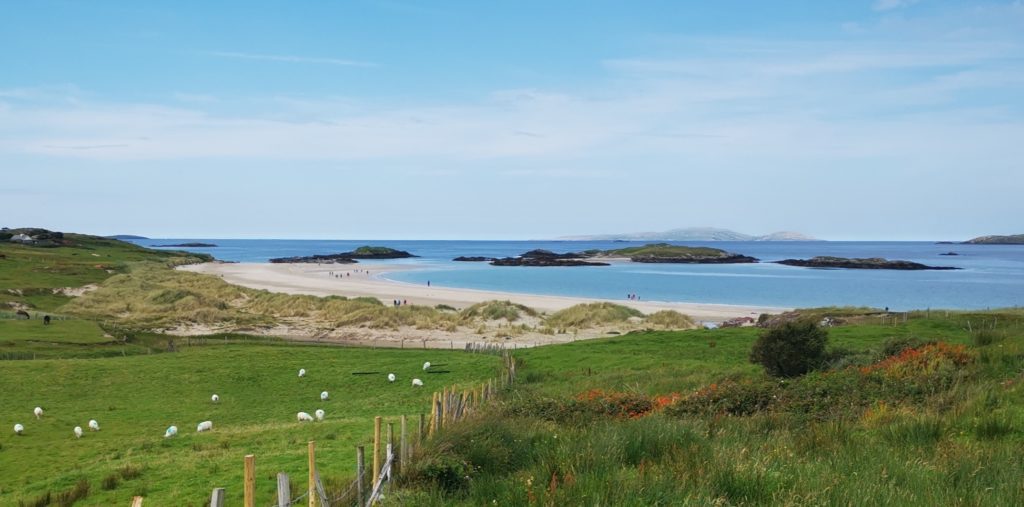
If you’re wondering when the best weather in Ireland is, this post will tell you exactly what you’re looking for.
The name ‘Emerald Isle’ lends itself to the unique, rich colour of the rolling grass landscapes which are found throughout Ireland. We all know grass needs moisture to grow, and in Ireland, that’s certainly found in abundance.
But grass also needs sunlight, which believe it or not, can also be found in Ireland! So when is the best weather in Ireland? This detailed post will show you exactly when to visit the Emerald Isle.
So, you are thinking of booking your trip but are unsure about the Irish climate? Maybe you have heard that it always rains in Ireland. I can say for sure that is not entirely the case! Let me explain…
Introduction
How would you describe the climate in Ireland?
The climate of Ireland is mild, humid and changeable with frequent rainfall and a lack of extremes in temperature.
Let’s call a spade a spade. There is plenty of rain in general in Ireland, in some places more than others.
There are many types of rain in Ireland in fact. It can rain sideways, straight down or from an unusual kind of 45 degree angle.
Sometimes it drizzles and turns your hair into an unwanted wave of inflated locks. Sometimes it rains in the next field but it’s dry where you are. Sometimes, rain and wind combine to take your breath away, literally.
It’s possible to go into your next town or village and get soaked wet and return home to blazing sunshine. Sometimes, it never rains for ages and the farmers start praying for the rain. Other times it rains too much and they pray for dry weather.
On the odd occasion there will be snow, ice and frost and the country shuts down for one or two days-the schools will close and local events will be cancelled. This is rare, but it is hilarious.
The bottom line is the main weather trend (particularly on the western half) is changeable.
Why does it rain frequently?
The Atlantic is huge. It carries a ocean of water, literally. The prevailing winds are west or south-west, which means the air is laden with moisture which dumps itself on poor old Ireland.
Ireland’s mountains are found primarily on the west coast, which allows this air to rise, condense and bucket down on top of many unfortunate Irish souls and tourists alike.
But quite often, that rain is in the form of a shower – quick and to the point, on to the next location and repeat the process. Almost constantly watering Ireland’s pastures at a scale some farmers in other countries could only dream about.
Now let’s get onto the technical stuff.
Rain
The distribution of rainfall throughout Ireland
There is a clear west-east divide here, as you can see illustrated by this graphic below. This is average yearly rainfall over a 30 year period. So the twofold effect of the western regions of Ireland being close to the Atlantic and the existence of the main mountain ranges along the western seaboard means that the highest amount of rainfall falls on western counties.
Rainfall quantities become less and less towards the east of the country. Simply put, the air has just run out of water by the time it gets to the east!
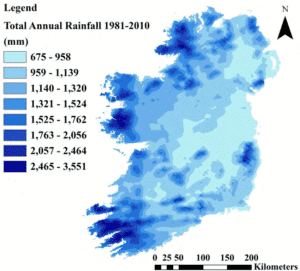
Don’t be too alarmed by the dark blue portions of the maps, this is where the main mountainous regions of Ireland are and are uninhabited (for obvious reasons!) But note, the east is substantially drier than the west. The county with the most rain is Kerry, on the south west of the country. But I have a little anecdote I would like to share…
I have been to Kerry numerous times and always stayed in the wonderful, lively town of Killarney. This particular situation has happened on many occasions but one particular day stood out. I set off with my tour in our bus one morning in Killarney and you could barely see the other side of the road, it was so foggy, it was so wet and windy.
The plan was to venture to Slea Head, on the very tip of the Dingle Peninsula.
This is a wonderful place, has some magnificent coastal scenery and has one of the highest concentration of prehistoric sites anywhere in the world. Anyway, it was discussed if we should even waste our time going there on a day like today.
What would be the point? You could barely see the hand in front of your face. In any case we kept going. By the time we got to Dingle, it had stopped raining. We investigated the weather as soon as we arrived in Dingle (because to be honest the reception was sketchy at best up to this point)
By the time we got to Slea Head, this is what awaited us:
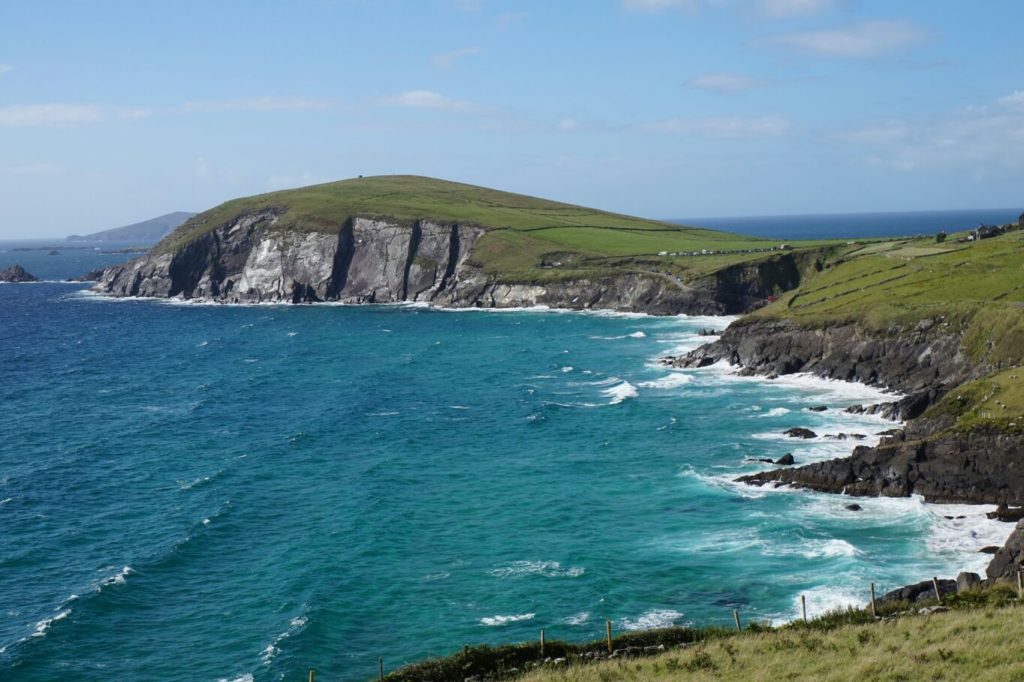
There are a whole host of great weather apps out there that can give you an indication of when rain is going to fall. This one for example is the national forecasting division: Met Eireann. You can track any rain coming in from the Atlantic and plan accordingly.
One often hears stories like the one above, where people go to the Aran Islands for the weekend and have glorious weather, while those on the mainland get poured on. There are micro-climates like this all around the country.
What are the drier months?
Shannon Rainfall Data
This is data from Shannon Airport weather station. Shannon is located on the west coast of Ireland.
| Year | Jan | Feb | Mar | Apr | May | Jun | Jul | Aug | Sep | Oct | Nov | Dec | Annual |
|---|---|---|---|---|---|---|---|---|---|---|---|---|---|
| 2022 | 46.6 | 146.1 | 41.3 | 48.2 | 51.9 | 65.1 | 399.2 | ||||||
| 2021 | 105.5 | 82.6 | 82.6 | 15.4 | 91.6 | 17.3 | 85.3 | 80.5 | 72.0 | 131.7 | 53.6 | 112.3 | 930.4 |
| 2020 | 74.8 | 244.5 | 97.4 | 39.6 | 16.2 | 84.0 | 130.6 | 174.8 | 41.6 | 114.8 | 102.2 | 131.0 | 1251.5 |
| 2019 | 71.4 | 58.4 | 177.2 | 68.2 | 30.8 | 55.8 | 51.0 | 167.2 | 108.1 | 101.9 | 104.9 | 117.1 | 1112.0 |
| LTA | 102.3 | 76.2 | 78.7 | 59.2 | 64.8 | 69.8 | 65.9 | 82.0 | 75.6 | 104.9 | 94.1 | 104.0 | 977.5 |
This is rainfall measured in mm (average per month) The LTA (long term average) gives a good indication of the drier and wetter months. The 6 months from April to September in this location are the driest (with August being an anomaly) The wettest period is from October to January. Have look at the Dublin chart below:
Result: Best time to visit the western regions of Ireland in relation to lowest rainfall amounts: April to September
Dublin Rainfall Data
| Year | Jan | Feb | Mar | Apr | May | Jun | Jul | Aug | Sep | Oct | Nov | Dec | Annual |
|---|---|---|---|---|---|---|---|---|---|---|---|---|---|
| 2022 | 16.7 | 91.9 | 41.4 | 37.9 | 55.9 | 48.2 | 292.0 | ||||||
| 2021 | 115.6 | 61.7 | 34.2 | 16.2 | 96.9 | 14.2 | 83.6 | 51.2 | 33.4 | 75.2 | 17.5 | 83.7 | 683.4 |
| 2020 | 39.6 | 141.5 | 30.7 | 13.6 | 8.3 | 68.9 | 100.7 | 89.3 | 56.3 | 80.4 | 55.6 | 79.5 | 764.4 |
| 2019 | 27.1 | 19.9 | 87.7 | 71.6 | 34.8 | 74.3 | 49.7 | 68.7 | 93.1 | 73.2 | 155.4 | 52.1 | 807.6 |
| LTA | 65.3 | 51.3 | 54.0 | 52.7 | 61.4 | 69.1 | 54.9 | 73.1 | 60.0 | 79.4 | 75.6 | 76.9 | 773.7 |
Now it’s getting interesting! First impressions are that there is significan9tly less rainfall in Dublin compared to Shannon. Second thing is that the spring months, starting in February and through to May make up the dry season. July and September also get relatively low rainfall and there is a spike in June and August.
Result: Best time to visit the eastern regions of Ireland in relation to lowest rainfall amounts: February to May and July, September.
Temperature
First of all, Ireland is influenced by the Gulf Stream or North Atlantic Drift – whichever name you prefer. Dublin’s position on the earth is almost on the same line of latitude as Minsk in Russia and Calgary in Canada.
These 2 locations are known for their bitter cold winters. But Ireland, luckily enough, does not suffer from any extremes in temperature. The reason being the influence of the Gulf Stream (a warm current of air which originates in the Gulf of Mexico).
Ireland receives the tail end of this and keeps the country ice-free and in general, snow is a rarity. Think of it as a huge thermostat that keeps the country in a constant state of mildness. That means it’s never that cold, it’s never that hot. I reckon a chart can show you this better than me rambling any more, so voila:
What are the warmer months?
Shannon Temperature Data
| Year | Jan | Feb | Mar | Apr | May | Jun | Jul | Aug | Sep | Oct | Nov | Dec | Annual |
|---|---|---|---|---|---|---|---|---|---|---|---|---|---|
| 2022 | 6.8 | 7.7 | 7.7 | 9.7 | 13.1 | 14.2 | 9.8 | ||||||
| 2021 | 4.5 | 6.7 | 8.0 | 8.7 | 10.4 | 14.2 | 17.8 | 16.3 | 15.7 | 12.4 | 9.0 | 7.8 | 11.0 |
| 2020 | 6.7 | 6.7 | 6.9 | 10.4 | 13.0 | 14.2 | 14.9 | 16.3 | 14.1 | 10.3 | 8.7 | 5.8 | 10.7 |
| 2019 | 6.8 | 8.4 | 7.8 | 10.1 | 11.8 | 13.6 | 16.8 | 15.9 | 13.8 | 10.0 | 6.7 | 6.6 | 10.7 |
| LTA | 6.0 | 6.2 | 7.7 | 9.4 | 12.0 | 14.5 | 16.3 | 16.0 | 14.1 | 11.1 | 8.3 | 6.3 | 10.7 |
The warmest months at Shannon are from May to September. You’re thinking: What? 16.3 degrees Celsius is the highest?! Remember, this is an average, that includes night temperatures. It’s normal to reach 20 degrees and above in these months, but 30 degrees? Sorry, nope, this is rare.
Result: Best time to visit the western regions of Ireland in relation to temperature: May to September
Let’s move over to the capital again and see what’s going on there? Does less rain mean more sun and warmth?
Dublin Temperature Data
| Year | Jan | Feb | Mar | Apr | May | Jun | Jul | Aug | Sep | Oct | Nov | Dec | Annual |
|---|---|---|---|---|---|---|---|---|---|---|---|---|---|
| 2022 | 5.5 | 7.1 | 7.7 | 8.6 | 12.9 | 14.3 | 9.3 | ||||||
| 2021 | 4.3 | 6.6 | 8.0 | 6.9 | 10.0 | 14.7 | 17.1 | 15.5 | 15.5 | 12.3 | 8.0 | 6.8 | 10.5 |
| 2020 | 6.6 | 6.2 | 6.6 | 9.7 | 12.3 | 14.1 | 15.2 | 15.6 | 13.7 | 10.1 | 8.6 | 5.1 | 10.3 |
| 2019 | 5.7 | 7.7 | 7.9 | 8.7 | 11.4 | 13.3 | 16.8 | 16.2 | 13.7 | 9.8 | 6.6 | 6.3 | 10.4 |
| LTA | 4.9 | 5.2 | 6.6 | 8.2 | 10.8 | 13.5 | 15.6 | 15.2 | 13.1 | 10.2 | 7.1 | 5.3 | 9.7 |
Well the answer is: not necessarily! The Irish Sea along Dublin’s coast, by the way, is not as strongly influenced by the Gulf Stream and therefore is a lot colder. So the cool breeze keeps the temperatures a little down. It’s interesting to see that the winters are significantly cooler along the east coast than the west.
Result: Best time to visit the eastern regions of Ireland in relation to temperature: May to September
Sunshine
Introduction
You’ve guessed it. Wherever there’s the most rain, then there’s the least amount of sunshine, and this lovely little map shows exactly that. Remember the little anecdote I mentioned earlier about Slea Head, located down along the south west coast of Ireland and also the Aran Islands?
You can see that this region, along with many of the westernmost tips of Ireland seem to have their own micro-climates.
Annual Sunshine Data
The standout locations here are the eastern seaboard, and particularly the counties of Waterford and Wexford, with a very respectable 1650 annual hours of sunshine. These regions are known in Ireland as ‘the sunny southeast’ and attract plenty of Irish holidaymakers during the summer months.
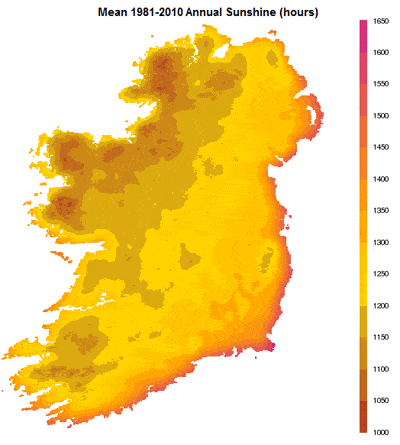
Here is one more wonderful little graphic to illustrate the seasonal distribution of sunshine hours.
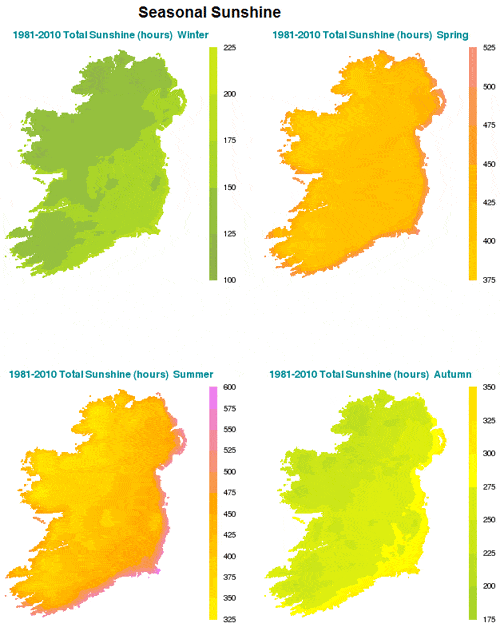
This consistently shows that the eastern half of the country wins out in the battle for sunshine hours, particularly the sunny southeast, with the spring and summer months coming up trumps.
Result: Best time to visit both the east and west of the country is spring and summer, with the eastern half producing the most amount of sunshine hours in total
Conclusion: When is the best weather in Ireland?
Best time to visit the western regions of Ireland in relation to lowest rainfall amounts: April to September
Best time to visit the eastern regions of Ireland in relation to lowest rainfall amounts: February to May and July, September.
Best time to visit the western regions of Ireland in relation to highest temperature: May to September
Best time to visit the eastern regions of Ireland in relation to highest temperature: May to September
Best time to visit both the east and west of the country in relation to sunshine hours is spring and summer, with the eastern half producing the most amount of sunshine hours annually
Some final thoughts:
The reason why I chose the 2 stations Dublin and Shannon is to show that there is a clear east-west divide when talking about rainfall, temperature and number of sunshine hours. There are other stations in the country which will show variations in all of these factors, but overall not a huge deviation from the average.
I hope I have given you some food for thought and showed some good, old fashioned data to help make your decision.
Remember, these are all averages and you may be blessed with wonderful weather in March or indeed October or November.
But overall, rain is a common occurence in Ireland, and you must come prepared.
When do I reckon is the best time to go to Ireland with regards to weather?
That depends what you would like to do while in Ireland. For example, should you just want to see Dublin and the other main town and cities, then it really doesn’t matter. Most of the time will be spent indoors enjoying many great museums, pubs or other attractions.
If you choose to explore the great outdoors of Ireland, then 100% the months from May to September. The winter months can be dark and grey with a very limited number of daylight hours.
If I was to whittle it down to just 1, 2 or 3 months, then I would choose May, June and September. The weather is getting warmer, there is less rain, you are not paying inflated prices for accommodation and flights, and Ireland is not as crowded.
FAQs
People wishing to visit Ireland have many questions regarding the weather! Here are some of the most commonly asked queries I have been asked down through the years.
Does Ireland have 4 seasons?
Ireland does not have 4 well-defined seasons that you may be used to in parts of continental Europe or parts of the USA. The Gulf Stream ensures that there are no extremes in temperature.
That means prolonged snow conditions are rare and temperatures that exceed 25 degrees Celsius are generally quite seldom, although it does happen, and can get well above that during a longer spell of high pressure.
How many days a year does it rain in Ireland?
Along the east coast, the average number of wet days (days with over 1mm of rain) is approximately 150, while on the west coast the average number is approximately 225 days. Note: 1mm of rain is a ridiculous definition of a rainy day. It’s a quick rain shower at best!
Does it get warm enough to go swimming in the sea in Ireland?
Yes! It can definitely get warm enough to go swimming. If the temperature exceeds 20 degrees in the summer months, then a day at the beach is an absolute must. Note that there is a huge difference in water temperature along the western half of the country compared to the east.
The Irish Sea is not as heavily influenced by the Gulf Stream as the Atlantic Ocean is on the western seaboard. This means the water here seldom exceeds 14 or 15 degrees in summer.
The warmest waters around Ireland are found along the south and southwestern counties, namely Cork and Kerry, where the water can reach 20 degrees after a spell of warm weather. If you visit a south-facing beach with shallow waters, the water can feel surprisingly warm! The waters tend to be at their warmest at the end of August.
Are there extreme weather events in Ireland?
The most extreme weather events Ireland experiences are Atlantic storms. These occur almost every year and in the last years have become more intense and frequent. They bring strong winds in excess of 120 kmph and heavy rains which sometimes batter the western and southern coasts.
Power outages can occur and sometimes coastal flooding. Many of these storms originate from the hurricanes in the Gulf of Mexico and Ireland sometimes gets the ‘tail end of them’.
In terms of the power and the damage they bring, they are nowhere near as strong as a hurricane, but sometimes lead to disruptions locally or a temporary grounding of flights. As mentioned, these occur in the late Autumn, winter months mainly.
As you know already, snow and ice are quite rare occurrences and therefore Ireland is not especially prepared for this! There have been prolonged cold spells, notably in 2010 where we had a month of freezing temperatures and snow.
This was a very rare occurrence and happens once every 10-15 years. The country practically shut down in some regions as there was a shortage of salt in the country. In response the government imported thousands of tons of salt in preparation for the next major event, but alas, it hasn’t happened since then!
Anything else I should know regarding weather/climate in Ireland?
Well, some may have an issue with the wind in Ireland. Ireland is one of the windiest countries in Europe, due to its isolated location in the Atlantic Ocean. Those of you who come from a more continental climate may not be used to the high humidity and almost constant wind, especially along the coasts.
The temperature may be 16 degrees, but with a high wind chill factor, which may make it feel like 12 degrees. Some may find the wind in winter quite cold, although the temperature may be 10 degrees, but may feel significantly colder. Just remember to bring a good windproof/down jacket and a woolly cap and you’ll be fine!
I would be delighted to answer any questions regarding the climate of Ireland or if you have any thoughts or comments, please let me know. Remember: there is no such thing as bad weather, just bad clothes!
